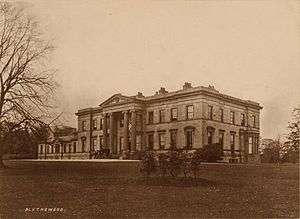Baron Blythswood
Baron Blythswood, of Blythswood in the County of Renfrew, was a title in the Peerage of the United Kingdom.[1] It was created on 24 August 1892 for Sir Archibald Campbell, 1st Baronet, the former Member of Parliament for Renfrew, with remainder failing heirs male of his own to five of his younger brothers and the heirs male of their bodies (one brother, Robert Douglas-Campbell, was excluded from inheriting the title).

Sir Archibald had already gained that style by being created a baronet (formally of Blythswood in the County of Renfrew, in the Baronetage of the United Kingdom) on 4 May 1880.[2]
Ancestry
Born Archibald Douglas, the first holder was the son of Archibald Douglas, 17th feudal Scots baron of Mains and 12th feudal baron of Blythswood, a patrilineal descendant of James Douglas (who had assumed by Royal licence the surname of Douglas in lieu of Campbell), son of John Campbell and Mary, daughter and heiress of John Douglas of Mains. However John himself was also landed as the son of Colin Campbell, 1st feudal Scots Baron of Blythswood and that estate passed to another branch of the family.
The British 1st Baron Blythswood's father was born Archibald Douglas but assumed his new patronymic on 1838 on inheriting the Blythswood estate on the death of his cousin, Archibald Campbell.
Succession
Lord Blythswood was childless and on his death in 1908 the baronetcy became extinct. He was succeeded in the barony according to the special remainder by his younger brother Reverend Sholto Douglas. On becoming the next Lord Blythswood he too assumed by Royal licence the surname of Campbell in lieu of his patronymic. He was also childless and was succeeded by his younger brother Barrington Douglas-Campbell, the third Baron. He was a Major-General in the British Army. He and his son had assumed the additional surname of Campbell by Royal licence in 1908 but on his succession to the barony in 1916 he assumed the surname of Campbell only by Royal licence. On his death the title passed to his eldest son, the fourth Baron. He was a Brigade Major in the British Army. As follows, on succeeding in the barony on the death of his father in 1918 he assumed by Royal licence the surname of Campbell only. He had no sons and was succeeded by his younger brother, the fifth Baron. He died unmarried and was succeeded by his younger brother, the sixth Baron. He assumed by Royal licence the surname of Douglas-Campbell in 1929 but on succeeding in the barony in 1937 he assumed the surname of Campbell only by Royal licence. The title became extinct on the early death of his son, the seventh Baron, in 1940 due to a car accident.
Estates
The principal home had been until the early 20th century Blythswood House, named after the vast estates in Glasgow which an ancestor started to feu off in the 1800s including Blythswood Hill and Blythswood Square to William Harley and other developers. The first baron, who served in Westminster's Houses of Parliament in the Commons as an MP and later as with subsequent generations in the Lords acquired the old manor house of Halliford in Shepperton which is where in the year of his death he has a large tablet monument in the church chancel by the Thames.[3]
Campbell Baronets, of Blythswood (1880)
- Sir Archibald Campbell, 1st Baronet (1835–1908) (extinct on death of 1st Baron) (created Baron Blythswood in 1892)
Barons Blythswood (1892)
- Archibald Campbell, 1st Baron Blythswood (1835–1908)
- Sholto Campbell, 2nd Baron Blythswood (1839–1916), brother of the above
- Maj Gen Barrington Bulkeley Campbell, 3rd Baron Blythswood (1845–1918), brother of the above
- Major Archibald Douglas, 4th Baron Blythswood (1870–1929) son of the above
- Barrington Sholto Douglas Campbell/Campbell, 5th Baron Blythswood (1877–1937) brother of the above
- Leopold Colin Henry Douglas Campbell/Campbell, 6th Baron Blythswood (1881–1940) brother of the above
- Philip Archibald Douglas Campbell/Campbell, 7th Baron Blythswood (1919–1940)[4]
Recognition
The merchant convoy ship "SS Baron Blythswood" under chief officer William Simpson Ure was sunk by U-99 in 1940.
References
- "No. 26328". The London Gazette. 23 September 1892. p. 5383.
- "No. 24840". The London Gazette. 30 April 1880. p. 2786.
- Robbins, Michael (2003) [1953]. Middlesex. Chichester: Phillimore. p. 325. ISBN 9781860772696.
- "Lord Blythswood killed in car accident". The Glasgow Herald. 17 September 1940. p. 6. Retrieved 30 April 2012.